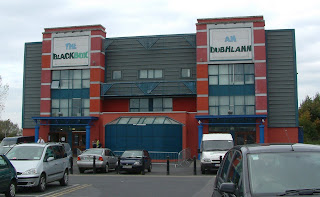The Black Box is a slightly shabby

theatre/function room in a retail park on the edge of Galway city. Yesterday it played host to the first Great Irish Beer Festival, an event viewed with no small amount of scepticism by the Irish online beer community, mainly because so few of the country's brewers signed up for it. The Porterhouse and Galway Hooker had their own stands, but most of the rest were run by importers and distributors. With the emphasis on bottled product, then, it was clear this wouldn't be in the style of a UK real ale festival. It was still highly enjoyable, however.
While waiting for the doors to open, I noted with trepidation the
Macnas van in the car park.

It must have been there in some other capacity, however, and there were mercifully no giant
papier maché pints dancing in formation through the venue. You just never know in Galway. Inside, attendees were issued with a starter pack of beer chips and a surprisingly decent plastic beer receptacle. This could be rinsed between drinks at the various water coolers around the room, which was just as well since a burst pipe cut off the building's mains water supply for a couple of hours in the middle of the event. Some time after it came back, the slops bins all disappeared from the floor, making glass rinsing very difficult indeed.

As I mentioned, just two Irish brewers were running stalls, though there was also Moling's and O'Hara's on tap. Lithuanica, distributors of the Švyturys range, were handing out mini-basketballs and guides to Vilnius: European Capital of Culture 2009. InBev had the best swag, though: Leffe glasses and Beck's hats. In fact, the InBev stand had an extensive range of glassware on display. Play to your strengths is the lesson here, I guess...
The entertainment was

mercifully acoustic, and the only Heineken and Guinness taps on show were for display purposes only, as part of a keg hire company's exhibit.
To the beer, then. I mentioned on Friday that the promise of
Budvar Dark was one of the major draws. It took some concerted searching to find it, the relevant barman having at first denied stocking it. Thankfully one of my ICB colleagues

persisted, and there was a brief roaring trade in the Czech black lager. Like most of the bottled beers, it was being served inappropriately cold and I was at first surprised by how sour Budvar Dark is. After a few minutes of warming this mellowed and an almost stout-like roasted grain flavour came through. The other eastern European I tried was
Švyturys Baltas, a wheat beer. It's served with lemon and is quite sparkly: hallmarks of a Belgian
wit, but the flavour is fruity, not spicy, with distinct banana notes, edging it closer to the German
weiss style. An odd and interesting beer.
Aussie beers seem to be growing in popularity in Ireland, though as yet we have few decent ones. I tried a Boag's
Strongarm at the festival: a powerfully sweet and malty golden lager with a dry bitter hops bite at the end. Surprisingly, given the taste and the name, this weighs in at only 5% ABV.
Most of the rest of what I drank was English. I have little to say about Wychwood's
Goliath: it's rather sugary and not to my taste.
BeeWyched gives off a pungent hops aroma, though this doesn't come through in the strong perfumy taste. Interesting, but you couldn't drink a whole lot of it. Finally,
Bah Humbug is Wychwood's Christmas ale and is much lighter than a Christmas ale has any right to be. The flavour is sweet, but there's not a whole lot else going on. I wish now I'd spent more time sampling the beers on offer from Black Sheep, which are rare in Dublin but apparently quite common in Galway's bottle shops. The only one I had was
Riggwelter, a marvellous black ale, with a strong caramel aroma and a complex taste full of sticky malt and bitter chocolate.
Everything else I tasted I'd had before, though it was the first time I tried the reformulated

Árainn Mhór Rua, now down to 5.2% from 6, due to a tendency to knock punters on their arses rather too quickly, which in turn was adversely affecting sales. It was great chatting to Aidan and Ronan of Galway Hooker as well. Thanks for your hospitality, guys.
All-in-all, a few organisational wrinkles to be ironed out, but generally a positive start to what will hopefully become a regular event. And here's hoping the next Great Irish Beer Festival will properly be a festival of great Irish beer.
 What will probably be the last beer of the year is another of my winter Canadians: Maudite from Unibroue. It's an interesting mix of the Belgian golden ale and the typical bière de garde. The former comes through in the rich, powerful and spicy flavour, the soft texture and also the mandatory demons on the label. The latter lends a dark amber colour, opaque as the yeast goes in at the end of the 75cl bottle, and also a lovely sweet and malty character.
What will probably be the last beer of the year is another of my winter Canadians: Maudite from Unibroue. It's an interesting mix of the Belgian golden ale and the typical bière de garde. The former comes through in the rich, powerful and spicy flavour, the soft texture and also the mandatory demons on the label. The latter lends a dark amber colour, opaque as the yeast goes in at the end of the 75cl bottle, and also a lovely sweet and malty character.




















































